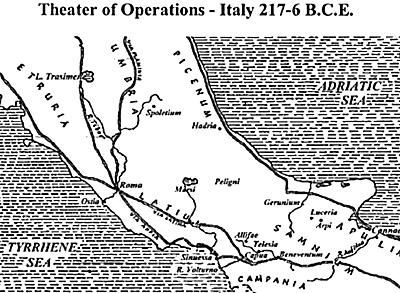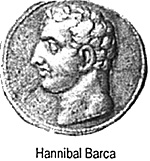(Publishers Note: This is an in-depth, detailed and fascinating study of what happens when modern knowledge of tactics and logistics is compared with what has been written in the historical record. This is the first of two parts; because of it's depth of analysis it takes up a lot of space, therefore the two parts. I hope you enjoy it as much as I have. KPR)
Cannae is the name of an unremarkable village in the Roman Italian province of Apulia. The name echoes through western military history as the devastating defeat of Roman Republican arms at the hands of the Carthaginian commander Hannibal Barca. A large multiLegion Roman force under the command of consuls Gaius Terentius Varro and Lucius Aemilus Paullus is destroyed beyond recovery [Polybios 111, 113-7; Livy XXII, 4150]. Tactically, Cannae is synonymous with a double envelopment maneuver which results in the annihilation of an opponent.
 Theater of Operations - Italy 217-6 B.C.E.
Theater of Operations - Italy 217-6 B.C.E.
Most of the specifics of the events which transpired this epic battle are in principle accepted by modern historians. Hans Delbruck, one of the originators of modern analytical military history, questions neither the basic events nor the numbers of participants present at Cannae. This is notable since in the same volume of his History of the Art of War Within the Framework of Political History: Volume I Antiquity, he is famous for his demonstration of the fallacy of the literal numbers reported by Herodotus for Xerxes' Persian invasion of Greece in 480 B.C.E. Delbruck explained, based upon known facts, the physical space occupied by a contemporary army corps of 30,000, that the length of the Xerxes' column of 4,200,000 men would stretch 2,000 miles. In the Excursus to Book V, the Second Punic War, Chapter 1, The Battle of Cannae, he argues against a critic of the traditional numbers and defends the numbers handed down by Polybios. He does give his analysis in reconciling the differences between the numbers as recorded by Polybios and those of Livy, but unlike his evaluation of Herodotus, he does no correlation with known contemporary military measures. These popularly accepted numbers are:
- Romans: 80,000 infantry and 6,000 horse
Carthaginians: 40,000 infantry and 10,000 horse
The objective of this article is to employed known standards to determine the validity and probability of the numbers. The analysis will initially focus on the Carthaginian forces. Once that number is determined, the area of deployment it could occupy will provide a basis in evaluating Roman numbers. The Romans' personnel numbers must fit within the base and arms of Hannibal's double envelopment even within the textual record of the Romans doubling their infantry's depth. It is also to be evaluated in the constraints of supportable logistics. The analysis leading to the revelation of numbers will begin with the events and the environment in which both antagonist find themselves before Cannae.
Prelude
 While the specifics of the events leading to and encompassing the Second Punic War are beyond the scope of this article, though worth reading, a short narrative of general details leading the antagonists to the battlefield before Cannae is presented. Hannibal Barca (at right) assembles and leads an allied coalition of Africans, Iberians, Gauls, and disaffected subjects of Rome through the Italian peninsula in 218 and 217 B.C.E. He breaks two legions under the consuls Tiberius Sempronius Longus and Publius Cornelius Scipio before the Trebia River in December 218 B.C.E. after clearing the Alps late in the year. The Senate enrolls a new set of consuls for the year and reconstitutes the forces to counter the enemy in their territory. By skill and maneuver, Hannibal annihilates two legions caught in road march under the consul Caius Flaminius at Lake Trasimeme, in June 217 B.C.E. The army then proceeds southeast down the peninsula, though stubbing its toe with an unsuccessfid and costly assault on the town of Spoletium. Hannibal then traverses in and through Picenurn plundering and raiding. From Hadria, he marches south to Marsi, Peligini, and the area on the Apulian border around Apri and Luceria.[Livy XXII, 9]
While the specifics of the events leading to and encompassing the Second Punic War are beyond the scope of this article, though worth reading, a short narrative of general details leading the antagonists to the battlefield before Cannae is presented. Hannibal Barca (at right) assembles and leads an allied coalition of Africans, Iberians, Gauls, and disaffected subjects of Rome through the Italian peninsula in 218 and 217 B.C.E. He breaks two legions under the consuls Tiberius Sempronius Longus and Publius Cornelius Scipio before the Trebia River in December 218 B.C.E. after clearing the Alps late in the year. The Senate enrolls a new set of consuls for the year and reconstitutes the forces to counter the enemy in their territory. By skill and maneuver, Hannibal annihilates two legions caught in road march under the consul Caius Flaminius at Lake Trasimeme, in June 217 B.C.E. The army then proceeds southeast down the peninsula, though stubbing its toe with an unsuccessfid and costly assault on the town of Spoletium. Hannibal then traverses in and through Picenurn plundering and raiding. From Hadria, he marches south to Marsi, Peligini, and the area on the Apulian border around Apri and Luceria.[Livy XXII, 9]
Shocked by the Carthaginian success, the Roman senate appoints Quintus Maximus Fabius as dictator. Fabius enrolls two new legions to replace the losses of Flaminius. These are joined with the remaining Roman forces under the previous co-consul Gnaeus Servilius. The dictator and his forces proceed around Rome and to the Italian region then under the enemy's sword. Arriving in country around Apri (modern Foggia), Fabius establishes his camp within sight of that of the Carthaginians. Hannibal immediately offers battle. Fabius declines [Livy XXII, 12]. Fabius' design was to leverage his army's advantages, greater manpower and secure provisions, against his opponent's weakness, inferior strength and reliance upon foraging [Polybios, Book 111, 89].
Fabius understood that his legions were neither disciplined nor adequately proficient to engage the seasoned host before them. Vexed that this new Roman commander was immune to the traditional Roman disease of bravado and vanity, Hannibal sought a new means to force a decisive battle. He turned to burning and pillaging the territory. In this course, he sought to alienate the Italians from their affiliation with Rome. Here was a large Roman army, willing to watch as the earth was scorched, but unwilling to fight to defend their homes and towns. How could Rome be their friend? Hannibal carries the torch through Samnium, capturing Telesia. He moves on to the rich lands of Campania. His troops run roughshod across the Falernian Fields as far as Sinuessa. Fabius' formations shadow his movements, remaining in the high ground.
Hannibal does not see the Italians abandon Rome under this campaign. He does understands logistics. He will have to establish winter quarters for provisioning his army. Due to the damage to the surrounding territory, he and Fabius know that he must find succor elsewhere. Fabius posts at the key passes out of the region what he believes are sufficient forces to keep his adversary in place. He believes that he can make the enemy wither on the vine without the possibility of long term sustainment. Hannibal has a different idea. He plans to move under the cover of darkness and with a ruse to escape the encirclement of terrain and Roman forces.
More History of Logistics: Part One
History of Logistics: Part Two
-
Returning to the Scene of the Action
Sustaining an Army
Supply, Size, and Tactics
The Writing of History
Back to Strategikon Vol. 1 No. 2 Table of Contents
Back to Strategikon List of Issues
Back to MagWeb Master Magazine List
© Copyright 2001 by NMPI
This article appears in MagWeb (Magazine Web) on the Internet World Wide Web. Other military history articles and gaming articles are available at http://www.magweb.com